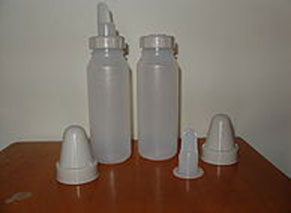One of the main concerns parents with babies born with clefts are how to feed their babies.
The first 24 hours of birth a newborn with a cleft will be fed through an oro-gastric tube.
Soon after that, a team comprises of a cleft lactation nurse, paediatrician and/or paediatric dentists will help mother to discover modified feeding methods for her newborn child that will be particular to her and the baby. This should allow proper nutrition and will certainly reduce maternal distress.
Can babies with cleft feed normally?
The opening into the mouth from the nose due to cleft causes a leak of air that prevents effective suction. If the infant has only a cleft lip, there should be no loss of suction and the infant can suck well from a bottle or a breast.
When the gum and lip are cleft, the infant’s suction may be reduced and the baby might need a bottle with a freer flow rate, such as one of the special plastic squeezed bottles on the market, or a faster flow nipple.
What about if the baby has a cleft palate only?
For a baby who has a cleft palate only, mother can have a choice either:
To breast feed directly OR mother will be encouraged to express her breast milk. Specialist cleft lactation nurse will then guide mother on how to feed EBM using soft (squeezed) bottle with a specialised and/or to use modified cross cut normal rubber teat
Breastfeeding an infant with a cleft palate is quite challenging unless the infant’s cleft palate is very far in the back of the mouth and very small. Nursing at the breast is best limited to 10 minute sessions, and supplemental bottles will be needed if breastfeeding alone does not supply enough food for adequate satisfaction and growth
My baby has complete cleft lip and palate, how am I going to feed him?
Feeding is more challenging for babies with cleft lip and palate as they will have an irregular, oval-shaped mouth. Infants struggle to get complete lip seal thus preventing enough suction in the nipple to draw out formula or breast milk from a bottle.
Specially designed bottle systems, nipples and flow valves aid in the comfort and effectiveness of feeding your newborn
For some babies, an acrylic custom-made feeding plate are placed at the roof of the mouth to help stabilized the nipple and create a barrier in between nipple and the palate for effective sucking and swallowing.
Tips of bottle feeding cleft babies using bottle
- Small but frequent feedings (3 hourly) are usual in the first weeks of life
- Give mother and the baby time to learn how to feed. Expect longer than expected feeding times. Try to limit feedings to 30 minutes with an additional 10 minutes for burping and changing.
- Baby is cradled in a semi-upright seated position (45 degree) to limit the amount of liquid entering the nose. Keep the baby’s head and shoulders in one hand and the bottle in the other hand. If mother are more comfortable with the baby in the crook of her elbow, place a folded blanket or flat pillow under that elbow to hold the baby more upright.
- Tickle the baby’s lower lip or corner of the mouth with the nipple and place it over the tongue when the baby’s head turns toward the nipple and the mouth pops open.
- After placing the nipple in the baby’s mouth, allow the baby to suck and breathe a few times before beginning any compression of the squeezed bottle. Begin with gentle compression and slowly increase the pressure
- Place the nipple in the mouth parallel to the floor so that it does not fill completely for the first few swallows. Once the infant has been comfortably breathing and feeding, mother may lift the bottle so that the nipple fills more fully
- Mother should not be alarmed to see occasional trickle of milk coming out of the nose. If there is a great amount of liquid in the nose, or if baby spits up, tilt the baby forward or to the side. The extra milk in the front of the mouth and nose will drain out by gravity.
- Remove the nipple from the baby’s mouth if you see any signs of distress, such as the head pulling back, coughing, no breath for 3-4 sucks or an alarmed look on your baby’s face. When calm behavior returns, begin again more slowly
What issues may arise preventing effective feeding?
The most common problems encountered are prolonged feeding times and an inadequate nutritional intake. This may lead to excessive burning of calories, which in turn compromises weight gain. Lengthy feedings may indicate that the flow of milk is too slow for the newborn. The lactation cleft nurse will try to help by modifying the size of the cross cut teat and reassess the baby’s suction.

Squeezed baby bottle with special ‘spoon-like’ teat
References
- Feeding a Child with Cleft Lip and Palate, Paediatric Cleft Lip and Craniofacial Centre Centre, Golisano Children Hospital
www.cleftline.org/who-we-are/what-we-do/feeding-your-baby/ - Your baby first year – Cleft Palate Foundation
www.cleftline.org/docs/Booklets/FYL-01.pdf - Cleft Lip and Palate Association United Kingdom – Feeding section
www.clapa.com/treatment/feeding/ - St Louis Hospital Cleft Palate and Craniofacial Centre – Tips of Feeding and Infant with Cleft Lip
http://www.stlouischildrens.org/our-services/cleft-palate-and-craniofacial-institute/tips-feeding-infant-cleft-lip
| Last Reviewed | : | 14 June 2017 |
| Writer | : | Dr. Mimi Syazleen bt. Abd Rahman |
| Accreditor | : | Dr. Leong Kei Joe |







